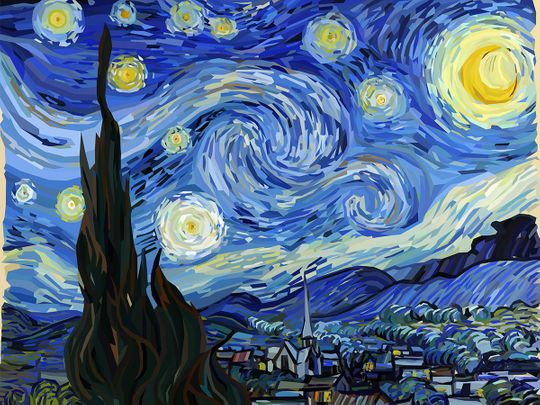
It’s likely you’ve seen Dutch artist Vincent van Gogh’s The Starry Night, with its mesmerising, swirling twilight sky. But did you know, there are a lot of secrets hidden within its layers?
Click start to play today’s Spell It, where you can find the word ‘starry’.
The Starry Night is a feast for the eyes, and one of the best-known works of art. Here are a few surprising facts about the impressionist painting:
1. It’s the view from an asylum
After years of psychiatric illness, van Gogh experienced a mental breakdown in 1888, and checked into the Saint-Paul de Mausole asylum in Provence, France. The view from his window at the asylum became the iconic painting, The Starry Night. In one of many letters to his brother Theo, van Gogh describes his view: “This morning I saw the country from my window a long time before sunrise, with nothing but the morning star, which looked very big.” However, art historians think the artist took some liberties with the view – for instance, he left out the window’s iron bars. And the village of Saint-Remy would not have been visible, but van Gogh included a village in his painting, anyway.
2. It was not his first rendition
Van Gogh created the painting that everyone knows and loves in 1889. But a year prior, he painted the original Starry Night, sometimes known as ‘Starry Night over the Rhone’. When he arrived in Arles, France in 1888, the artist became obsessed with the night sky, and the twinkling of lights within it. He tried his hand at capturing it in 'Café Terrance on the Place du Forum', before his first Starry Night.
3. He didn’t love it
As with most creative people, van Gogh was his own biggest critic. He talked about the works that would become known as his Saint-Paul Asylum, Saint-Remy series, in his letter to Theo, saying: “All in all the only things I consider a little good in it are the Wheatfield, the Mountain, the Orchard, the Olive trees with the blue hills and the Portrait and the Entrance to the quarry, and the rest says nothing to me."
4. He painted Venus without realising it
Starry Night has been analysed over and over by modern scientists, with surprising results, each time. In 1985, US-based art historian Albert Boime from the University of California, Los Angeles, compared the artwork to a planetarium’s recreation of the night sky on June 19, 1889 – the night van Gogh would have painted it. The similarities could not be denied, proving that the artist’s “morning star”, which he talked about in his letter to his brother, was actually the planet Venus.
5. He captured turbulence in his painting
Another surprising reveal from Van Gogh’s painting, is how accurately he depicts the concept of turbulence. In 2004, scientists using the Hubble Space Telescope, saw the eddies of a distant cloud of dust and gas, surrounding a star, and stated that it reminded them of Van Gogh’s Starry Night. Scientists from Mexico, Spain and England then put his art under a microscope, to study luminance – the intensity of light in the colours of the canvas. They discovered that Van Gogh’s paintings held a distinct pattern of fluid turbulence – remarkably similar to how Nature works.
Did you know these facts about Starry Night? Play today’s Spell It and tell us at games@gulfnews.com.








